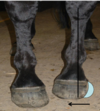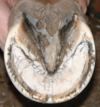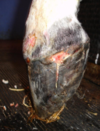Foot and Farriery Flashcards
What are the aims of foot balance?
Aims of foot balance
- Promote even weight bearing (static and dynamic)
- Level foot fall
- Facilitate ease of movement
What are the 3 dimensions of foot balance?
Three Dimensions of foot balance:
- Medial Lateral (long axis)
- Hoof Pastern Axis
- Foot Shape (Solar View)
What dimension of foot balance is this?

Lateral (Long Axis)
In this image can see that on this shoe that the farrier has achieved medio lateral balance by making one side thinner than the other.
What foot balance view is this?

Hoof Pastern Axis
Limb on the right is a broken forward HPA coranet band has moved forwards and toes has gone backwards. More strain on this limb.
What foot balance view is this?

Foot Shape (Solar View)
Both images show a very good shape
Front feet tend to be heart shaped
Hind feet tend to be diamond shaped
What are we aiming for with foot balance?

we are aiming for even distribution of forces
What is the role of foot balance in treatment of lameness?
Foot balance
All three dimensions must be as near as possible to the ideal
Left: neglected horse
Right: same horse after trimming

What is the role of shoeing in treatment of lameness?
Shoeing
- Shoe must fit the foot
- Shoe must function as intended
- Shoe must not inhibit foot’s optimum function
Objective is to achieve a balanced foot with a normal axis
- Trimming is most important part
Shoe is only there for:
- protection against unnaturally abrasive surfaces
- Extra grip for XC or SJ
- Surgical or pathological reasons
What is a working relationship?
Consist of:
- Owner
- Vet
- Farrier
Critical for effective management of lameness/conditions
Often are the first things to break down
What area of expertise does a farrier have?
Farrier
- Training (apprenticeship) 4 years 4 months
- Anatomy of lower limb
- Biomechanics
- Farrier theory
- Shoemaking/shoeing
- Run a business
Further Examination
- Diploma of WCF
- AWCF
- FWCF
How does the code of conduct apply to the relationship between farrier and vet?
Code of Conduct:
- Attend cases at the same time (if possible)
- Dialogue between vet and farrier (essential)
- Share knowledge of individual horse/owner
- Don’t pass messages to farrier via the owner
- Don’t express an opinion about the farrier’s work to the owner - call the farrier
- Discuss cases together, decide the way forward, keep the owner in the loop with simple explanations/updates
What are corrective shoes?
Shoes designed to:
- Redress balance (where foot balance can’t)
- Alleviate conformational abnormalities
- Improve gait abnormalities
- Support hoof capsule imbalance
Also known as:
- Remedial
- Therapeutic
- Surgical
- Special
What kind of corrective shoe is this?

Straight-bar shoe
- 360 support
- Load/off load
- Heel support
- Increased ground surface
- Equal weight distribution
Conditions
- Sheared heels
- Hoof cracks
- Many other conditions it is useful for though
- Often used for things to do with balance
- Straight bar removes independent movement of the heels and distributes movement 360 degrees around the foot
What is being treated here?

Sheared heels and shunted coronet band
Can be brought down over time by trimming and shoes and unloading the area
What common corrective shoe is this?

Egg-bar Shoe
- 360 support
- Load/off load
- SDFT support
- Fetlock joint
- Moves COG rearward
Conditions
- Strained SDFT
- Navicular
- Caudal foot pain
Extends behind heels of the foot so moves the centre of gravity
Extra length allows support of ST structures
What corrective shoe is this?

Egg bar shoe
What common corrective shoe is this?

Heart-bar shoe
- 360 support
- Load/off load
- Frog support
Conditions
- Hoof cracks
- Frog support
- Frog pressure
- Laminitis (radiograph prior to fitting, supports digital cushion and other structures trying to head south in laminitis)























